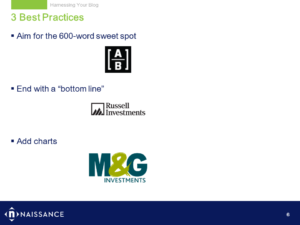The Top 3 Videos of 2016 (So Far)
Over the past few weeks I’ve spent A LOT of time looking at asset managers’ video content. I learned many things, but the most fun question to consider is a simple one: which videos are the best?
Below is a wholly subjective Top 3 list based on content posted to the YouTube catalogs of 25 firms since the start of 2016. Before we get there, a few quick thoughts:
- There is a high-degree of sameness. Lots of talking heads covering lots of the same issues in similar formats. In fairness it’s not all that easy to be truly original with video in this industry.
- Scripts are limiting. Having non-actors who are required to stick to a tight script is often a detriment in terms of being able to connect with presenters. Looser presentations have a little more snap to them.
- Nothing is viral. It seems 98% of the video have view counts in the three figures (or less).
- Production values are universally strong. Firms have mastered incorporating different angles, music, graphics, quick edits, and more.
That said, let’s get to the top 3…
3. Janus: Denver Pride Fest
So many firms have videos that TELL you about their culture. Voiceovers, brief looks at people in the office in various settings, you know the drill. This clip succeeds where those fall short – it SHOWS genuine aspects of the Janus culture. The video is only viewable on YouTube so click here or the image below to watch.
2. PIMCO: Asset Allocation for Equities in 2016
Over 25 seconds PIMCO uses one question, two statements, and two simple graphics to deliver its fundamental guidance on how the equity markets will go over the course of the year. No long-winded speeches, no multi-page paper… just a direct and clear message.
1. Schroders: Hidden Talent – Muy Thai
I am not sure how many topics would be more unexpected than Muy Thai in a video from an asset manager.










